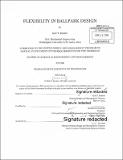| dc.contributor.advisor | Richard de Neufville. | en_US |
| dc.contributor.author | Ressler, Kyle T. (Kyle Thomas) | en_US |
| dc.contributor.other | System Design and Management Program. | en_US |
| dc.date.accessioned | 2014-10-08T15:25:08Z | |
| dc.date.available | 2014-10-08T15:25:08Z | |
| dc.date.copyright | 2014 | en_US |
| dc.date.issued | 2014 | en_US |
| dc.identifier.uri | http://hdl.handle.net/1721.1/90723 | |
| dc.description | Thesis: S.M. in Engineering and Management, Massachusetts Institute of Technology, Engineering Systems Division, System Design and Management Program, 2014. | en_US |
| dc.description | Cataloged from PDF version of thesis. | en_US |
| dc.description | Includes bibliographical references (pages 106-110). | en_US |
| dc.description.abstract | This thesis documents the potential value of using flexible design to implement Major League Ballparks (MLBP). Credible evidence suggests that most ballparks were designed to fixed specifications that do not facilitate improvements after the park opens. By contrast, flexible designs include options such as increasing seating capacity, adding luxury boxes, installing a retractable roof, or even converting spaces to accommodate alternative uses. The analysis estimated the economic value of flexible MLBP by comparing fixed and flexible designs. Fixed designs were based on deterministic forecasts of future conditions and largely ignore the uncertainties that affect the economic value of ballparks. Flexible designs recognize the great uncertainties concerning future attendance, concessions spend, weather, and inflation rate. Flexible designs both anticipate and plan for these uncertainties. The economic evaluations used 30-year Net Present Value Monte Carlo simulations of possible futures. They used historical data available at the time of design to estimate the distribution of uncertainties. For the flexible designs, the analysis evaluated the options and determined key parameters such as strike point, base level, and option level. The analysis is based on actual ballpark cases. These include two completed ballparks -- for a small market (Minnesota Twins) and a large one (New York Yankees). For these ballparks, the analysis compared the actual ballpark with a flexible design. Additionally the value of amenities such as multi-use spaces, museums, and other features are explored. The results show that flexible design can significantly improve the long-term financial prospects of ballparks. It can lower initial investments and thus the Value at Risk (VAR). It can also increase the potential to cash in on favorable circumstances, that is, to increase the Value to Gain (VAG). While the specifics of each flexible design differ the overall conclusion is similar: Projects that embrace flexible design expect to achieve better long-term financial results. | en_US |
| dc.description.statementofresponsibility | by Kyle T. Ressler. | en_US |
| dc.format.extent | 110 pages | en_US |
| dc.language.iso | eng | en_US |
| dc.publisher | Massachusetts Institute of Technology | en_US |
| dc.rights | M.I.T. theses are protected by copyright. They may be viewed from this source for any purpose, but reproduction or distribution in any format is prohibited without written permission. See provided URL for inquiries about permission. | en_US |
| dc.rights.uri | http://dspace.mit.edu/handle/1721.1/7582 | en_US |
| dc.subject | Engineering Systems Division. | en_US |
| dc.subject | System Design and Management Program. | en_US |
| dc.title | Flexibility in ballpark design | en_US |
| dc.type | Thesis | en_US |
| dc.description.degree | S.M. in Engineering and Management | en_US |
| dc.contributor.department | System Design and Management Program. | en_US |
| dc.contributor.department | Massachusetts Institute of Technology. Engineering Systems Division | |
| dc.identifier.oclc | 891138803 | en_US |
